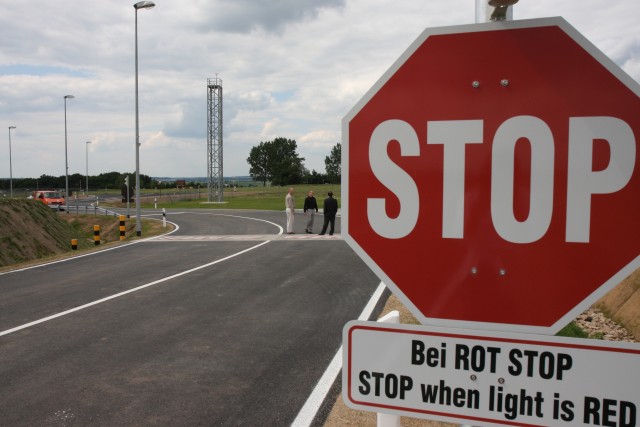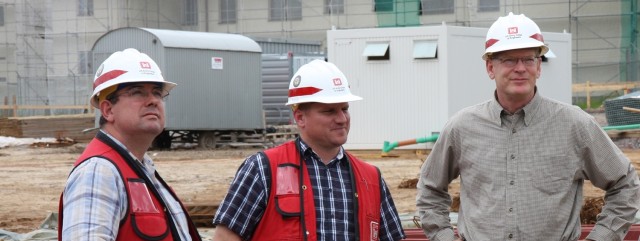One can easily overlook the small U.S. Army Corps of Engineers office on the U.S. Air Force base in Spangdahlem, Germany. Eyes are quickly drawn to the state-of-the-art air traffic control tower, the new houses under construction, and the new South Gate, which has an advanced large vehicle inspection station (LVIS - pronounced "Elvis") to provide essential security to the growing base.
But shrouded by the shadows of these striking facilities are project engineers like Martin Ritzmann, Shaun Frost, and Louis Reagan, who humbly go about their daily business as the unheralded force of all this new base construction. It is because of them - and the projects they've been commissioned to execute - that this base has transformed. And it is because of them that this base will continue to transform to assist its host wing - the 52nd Fighter Wing - in continuing to project superior combat power across the globe.
Its transformation started simply enough. When the Rhein-Main Air Base closed in 2005, Spangdahlem went from an overlooked training site to a principal handler of heavy-duty aircraft like C-5 Galaxies and C-17 Globemaster IIIs.
At the time, $175 million went to making the air base better equipped
for its new duties. Unfortunately, officials say, not everything needed was taken care of immediately.
In August 2008, for instance, Spangdahlem is scheduled to finally receive a $6 million air traffic control tower that could provide a far enough "line-of-sight" to adequately guide and direct traffic.
The project, managed by Ritzmann, includes "two of everything" to provide essential backup of cooling and power units and to provide a training simulator that can mimic other U.S. Air Bases, allowing for outgoing operators to begin directing traffic on their first day at work.
The completion of this new tower - obviously an essential part of the base and something that would seem to have been given a high priority - denotes the magnitude of other improvements occurring here as well.
To wit, currently the community of Spangdahlem depends on the small and isolated Bitburg Annex for its base exchange, commissary, and schools. Although Bitburg is only a 20-minute drive away, the winding and often dangerous commute for daily essentials led planners to diagram the best way to close Bitburg and make Spangdahlem self-sufficient.
And that's exactly what's happening, with over $230 million in construction earmarked for all new facilities, including a base exchange and commissary complex and a highschool.
As for the airmen stationed at Spangdahlem, a whole new housing program managed by Frost and Reagan was put into place recently to offer them some of the comforts of home, including American wiring, new cabinetry, built-in closets, and a large American-style kitchen.
"I don't want to say it's like living back in the States," said Frost, "because part of living here is getting to know the German culture and people. But it makes things nicer and more comfortable."
The 139 new units - 63 duplexes, two triplexes. and seven senior officer quarters - seek to provide comfort and improved standards of living to all the Airmen and their families stationed here, officials say.
The newest proof of progress to occur on base was the completion of the $5 million South Gate and LVIS, which were both unveiled at a ribbon-cutting ceremony June 17.
Ritzmann, the engineer for the projects, said these were necessary improvements, as gate guards working at the old gate previously worked under a "small tent" with virtually no protection against weather , aggressive drivers, or terrorist activities. Even the road the gate was on was unable to support the weight of large vehicles.
The new site, however, saw the completion of a many new safety features, along with a 45-degree berm, making any deviation from the main road impossible. Within the gate, cameras inspect every angle of oncoming vehicles.
In his speech at the ribbon-cutting ceremony, Terry Bautista, Europe District's chief of engineering and construction division, remarked that, for about $6 million, "We were able to construct a gate house and two small guard houses, a canopy, a guardhouse, a new barrier, and a new checkpoint system that requires fewer personnel to man. Plus, we now have new utilities, a new road, new parking areas, and better anti-terror and force-protection measures. I think that's pretty great."
If the current workload of these three Corps representatives seems daunting, it pales next to what could be coming. Soon, the District will tackle a new medical clinic, along with the infrastructure for the new school, BX, commissary, and fitness center, said Reagan, all of which will be placed on the relatively new 125-acre piece of land called the "Northwest Expansion" that the Air Force purchased after the Rhein-Main Air Base closure. "A lot of stuff is coming out of the pipeline now," Reagan said.
Despite the full construction docket, things in Spangdahlem are running quite smoothly, officials say.
"For the most part, [we have had] nothing I would call an obstacle," said Reagan. "We run into glitches all the time. It has nothing to do with processes or personalities; it is just the normal things you run into on a project site."
Base officials even say they can't believe the rate of progress the District has been able to manage.
"It's been a pleasure working with the Army Corps of Engineers here at Spangdahlem," said Capt. Matt Welling, 52nd Civil Engineer Squadron Asset Management Flight Commander. "Their dedicated professionals truly kept our needs as the customer as their highest priority. The Corps of Engineers ensured delivery of quality housing facilities on time and ready for immediate occupancy - a tremendous increase in quality of life for the Airmen living on Spangdahlem."
These engineers will continue their focus on their projects and on quality of life as their community transforms in front of their eyes.










Social Sharing